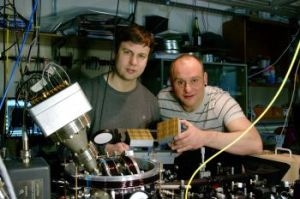Feb 2 2017
 Prof Winfried Hensinger and Dr Bjorn Lekitsch behind a quantum computer prototype at the University of Sussex. Credit: University of Sussex
Prof Winfried Hensinger and Dr Bjorn Lekitsch behind a quantum computer prototype at the University of Sussex. Credit: University of Sussex
The first practical blueprint for how to build a quantum computer, considered to be the most powerful computer on Earth, was recently unveiled by an international team headed by a scientist from the University of Sussex.
The great advancement towards developing a universal quantum computer was published on 1 February 2017 in ‘Science Advances’, a leading journal. It has already been established that such a computer would revolutionize commerce, science and industry on a scale similar to the invention of ordinary computers.
This new research deals with the actual industrial blueprint for constructing such a large-scale machine, a lot more powerful in solving specific issues than any of the previously constructed computers.
Once constructed, the capabilities of the computer highlight that it will have the potential to answer many questions in science; solve the most mind-boggling scientific issues; develop new, lifesaving medicines; unravel the yet to be explored mysteries of the furthest reaches of deepest space; and solve a some issues that would take billions of years to compute by an ordinary computer.
The work features a new invention allowing the transmission of actual quantum bits between individual quantum computing modules in order to attain a complete modular large-scale machine that has the potential to reach almost arbitrary large computational processing powers.
Earlier, scientists had planned to use fiber optic connections to connect separate computer modules. The new invention introduces connections developed by electric fields that enable the transportation of charged atoms (ions) from one module to another. This new approach enables connection speeds that are 100,000 times faster between individual quantum computing modules, compared to the existing state-of-the-art fiber link technology.
This new blueprint has been developed by an international group of scientists from the University of Sussex (UK), Google (USA), Aarhus University (Denmark), RIKEN (Japan) and Siegen University (Germany).
For many years, people said that it was completely impossible to construct an actual quantum computer. With our work we have not only shown that it can be done but now we are delivering a nuts and bolts construction plan to build an actual large-scale machine.
Prof Winfried Hensinger, Head of Ion Quantum Technology Group at the University of Sussex
Bjoern Lekitsch, lead author, also from the University of Sussex, explains: “It was most important to us to highlight the substantial technical challenges as well as to provide practical engineering solutions”.
The team next plans to build a prototype quantum computer, based on this design, at the University.
The effort is part of the UK Government’s plan to develop quantum technologies towards industrial exploitation and uses a latest invention by the Sussex team in order to replace billions of laser beams needed for quantum computing operations within a large-scale quantum computer with the easy application of voltages to a microchip.
The availability of a universal quantum computer may have a fundamental impact on society as a whole. Without doubt it is still challenging to build a large-scale machine, but now is the time to translate academic excellence into actual application building on the UK’s strengths in this ground-breaking technology. I am very excited to work with industry and government to make this happen.
Prof Winfried Hensinger, Head of Ion Quantum Technology Group at the University of Sussex
The possibilities of the computer to solve, explain or develop could be endless. However, the size of the computer will indeed be anything but small. The machine is likely to fill a large building, comprising of a sophisticated vacuum apparatus featuring integrated quantum computing silicon microchips holding individual charged atoms (ions) using electric fields.
The blueprint for constructing such computers has been made public in order to ensure that scientists from all over the world can work together and further develop this brilliant, ground-breaking technology besides promoting industrial exploitation.